
MAY CONTAIN NUTS

Search Shorpy
SHORPY ART

Framed or unframed, desk size to sofa size, printed by us in Arizona and Alabama since 2007. Explore now.
Join and Share
Ad-Free Shorpy
Shorpy is funded by you. Patreon contributors get an ad-free experience.
Learn more.

Recent comments
- Recent view
- Hudson’s Big Store
- Say what??
- Grapes?!
- A Beautiful Moment
- Such joy
- Bethune-Cookman University today...
- Yellow sky at morning
- Side Winder
- Air Quality?
- Sojourner Truth riot
- None were so blind(ed)
- The less famous sister
- Good ol' days?
- Rise and Fall
- Goo Goo Ga Joob
- Ticket Retention
- Not the only one
- Vagaries of War
- Killed by Amtrak
- Back to the Future
- Wanted --
- If you can't stand the light
- Centralized Traffic Control, I believe
- What's really happening
- Heckuva remote control!
- Sometimes — Things Go Bump!
- I SEE THE LIGHT
- Union Switch and Signal Company
- Get That Light Out Of My Eyes
Member Photos
The Shorpy
Print Emporium
Print Emporium
Search Shorpy
Search results -- 30 results per page
- Migrant Jalopy: 1939
- ... Valley over this ridge. View full size. Photograph by Dorothea Lange. (The billboard up ahead: "76 miles to GRAPEVINE air cooled cafe.")
... Posted by Dave - 08/05/2012 - 10:53am -
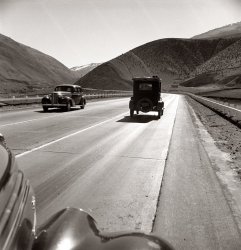
- Trunk Show: 1936
- ... in California." Dust Bowl migrants photographed by Dorothea Lange for the Farm Security Administration. View full size.
Brave ... Posted by Dave - 09/14/2013 - 6:17pm -
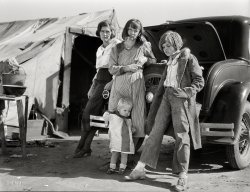
- A New Beginning: 1939
- ... View full size. Medium-format nitrate negative by Dorothea Lange for the Farm Security Administration.
If I Had a Pony Lyle ... Posted by Dave - 07/24/2012 - 7:05pm -
![A New Beginning: 1939 October 1939. "Ex-Nebraska farmer now developing farm out of the stumps. Bonner County, Idaho." View full size. Medium-format nitrate negative by Dorothea Lange for the Farm Security Administration.
If I Had a PonyLyle Lovett's grandpa, possibly?
A perfect character study...Sheer timeless quality.
Mr. FarmerThat's what you call your iconic American face.
In a word...Rockwellian.
[Or Grant Woodian. - Dave]
Urban Cowboys take noteThis is why NONE of you should wear your "cowboy" hats or anything else that takes your fancy from J Peterman's. Do you see how this man looks, how right that hat fits him in every way? On you it has the exact opposite effect. I'm begging you, put the hat down and just walk away.
The hatMy grandfather wore a similar style hat all the time. He was an Alabama cotton farmer (Jefferson County) who would still use mules to plow the fields. Hats served as a shade from the hot summer sun, a temporary water holder for giving the mules a drink, and when thoroughly soaked in water, the hat would keep your head cool as the water evaporated. Usually farm folks had two or three different hats...a work hat, a meeting hat when you went to town, and a dress hat for church. Same story with shoes too as I remember it.
If hats were still popularWouldn't it be great if hats were worn for more than just style today? I'd wear a hat like this. With all the talk of skin cancer, I'd like to see them become more than a fashion statement. Of, course, I don't think I could ever look as great as this gentleman. I'd bet he was a pleasure to talk to.
Many HatsMy grandfather wore a similar style hat all the time. He was an Alabama cotton farmer (Jefferson County) who would still use mules to plow the fields. Hats served as a shade from the hot summer sun, a temporary water holder for giving the mules a drink, and when thoroughly soaked in water, the hat would keep your head cool as the water evaporated. Usually farm folks had two or three different hats -- a work hat, a "meeting hat" for when you went to town, and a dress hat for church. Same story with shoes too as I remember it.
(The Gallery, Dorothea Lange, Portraits, Rural America)](https://www.shorpy.com/files/images/8b35558u.thumbnail.jpg)
- Home Is Where the Tent Is: 1939
- ... Willow Creek area, Malheur County, Oregon. Photograph by Dorothea Lange for the Farm Security Administration. View full size.
Horse ... Posted by Dave - 09/08/2011 - 5:17pm -
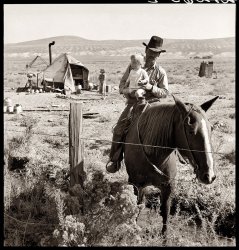
- Young Family, Penniless: 1936
- ... where they were working as field laborers." Photo by Dorothea Lange for the Resettlement Administration. View full size.
Ties That ... Posted by Dave - 04/20/2013 - 8:56am -
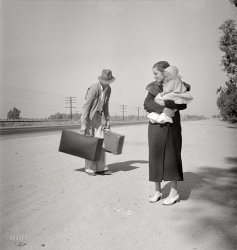
- Dead Ox Kids: 1939
- ... Malheur County, Oregon." Medium format nitrate negative by Dorothea Lange for the Farm Security Administration. View full size.
... Posted by Dave - 07/30/2012 - 2:45pm -
![Dead Ox Kids: 1939 October 1939. "The Free children in doorway of their dugout home in Sunday clothes. Dead Ox Flat, Malheur County, Oregon." Medium format nitrate negative by Dorothea Lange for the Farm Security Administration. View full size.
Saggjn' but not braggin'That young man second from left would certainly be "fashion forward" with the 5 inches too big in the waist pants but for A) I'm sure he's not wearing them that baggy on purpose and B) he'll make do because it's likely these or nothing he's got the sense to keep 'em up with a pair of suspenders.
Lest we think their home is oddHere's a blog (with a tip o' the hat to Shorpy) about Dead Ox Flat, and as you'll see even the town church was built Dug Out Style. Makes sense because the area seems to be on the plains, and in Oregon that means major snow and bitter cold.
http://www.hamell.net/2010/07/dead-ox-flat-oregon/
The flats.Definitely the "dry " side of Oregon ! I live in the state as well in a area known as Rabbit Flat, down in Klamath County. There were a few dugouts built way back when but they are long gone now.
Oregon FarmerWe are farmers! Okay, not that Farmers. The company insuring this home started out in the publishing business and branched out from there. Today, affilliates are all over the west, mostly offering Health and Life Insurance- Farmer-Stockman. Farm Progress (an ABC/Disney Company) now owns the original magazine publishing empire and still prints today.
Hand Me DownsI'm thinking, BamBam, that's he's stuck with Pa's hand me downs while his brothers get his old clothes. It's funny, today people just wear suspenders to simply wear suspenders, when this kid is wearing them because he has no choice.
Down in the dirtBut not down in the mouth. These kids are happy and they and their clothes are clean, even if a touch the worse for wear. No small accomplishments in the 1930s.
And cute little curtains hang in the windows, to boot. I bet this family is resourceful!
My GrandpaThis photo is of my Grandpa and 3 of his siblings. He's the one on the far left in the back.
[Great! Can you put names to them all? Had you see this photo before? - tterrace]
(The Gallery, Dorothea Lange, Rural America)](https://www.shorpy.com/files/images/SHORPY_8b35199u.thumbnail.jpg)
- The Whitfields: 1939
- ... Carolina." View full size. 35mm nitrate negative by Dorothea Lange for the Farm Security Administration.
Daddy's little girl I ... Posted by Dave - 09/09/2011 - 11:48am -
![The Whitfields: 1939 July 1939. "Tobacco sharecropper's house. White family. Rural rehabilitation clients. Whitfield family. Near Gordonton, North Carolina." View full size. 35mm nitrate negative by Dorothea Lange for the Farm Security Administration.
Daddy's little girlI bet he didn't spoil her (much).
CropsSomeone was asking about the crops grown here.
Gordonton is in Person Co., not too far from Granville Co.
Rural RehabilitationInteresting caption. But just what are rural rehabilitation clients? Sounds like a classification that a federal bureaucrat would come up with!
[Google books link - Dave]
A roving eyeShe's grown heavy from having four children and tries to keep her family and herself looking nice. He has a roving eye and considers himself quite a dandy. He holds his cigarette the way the guys in the movies do. He'll go away before long. Interesting that the brim of his hat echoes the roofline, wavy and worn.
(The Gallery, Dorothea Lange, Kids, Rural America)](https://www.shorpy.com/files/images/8b33811u.thumbnail.jpg)
- On the Road: 1939
- ... View full size. Medium format nitrate negative by Dorothea Lange for the Farm Security Administration.
Travelin' Man No doubt ... Posted by Dave - 07/30/2012 - 2:43pm -
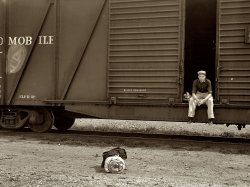
- Zollie Lyons: 1939
- ... View full size. Medium-format nitrate negative by Dorothea Lange.
They all look so tired.... Life must not have been too easy back ... Posted by Dave - 03/10/2009 - 12:23pm -
![Zollie Lyons: 1939 July 1939. "Zollie Lyons, Negro sharecropper, home from the field for dinner at noontime, with his wife and part of his family. Note dog run. Wake County, North Carolina." View full size. Medium-format nitrate negative by Dorothea Lange.
They all look so tired....Life must not have been too easy back then.
Dog run?What dog run?
[Reference to a southern style of architecture. - Dave]
Re: Dog RunOne purpose of the dog run was to serve as a sort of firebreak. The kitchen was on one side. If a fire broke out there, perhaps the rest of the structure could be saved.
The Lyonses It would be interesting to know what the war did to this family; the years of Southern sharecropping were drawing to a close, and the war could have provided work in factories in the Northern cities.
Additional reading If one wanted to get a real sense of how life was for sharecroppers in the South during the Depression, I can suggest a novel called "Hold Autumn in Your Hand" by George Sessions Perry. I don't know if the book is in print, but used copies are probably at Amazon. I stayed up all night to finish this one.
A good non-fiction work about sharecropping in the South is called "The White Scourge: Mexicans, Blacks, and Poor Whites in Texas Cotton Culture" by Neil Foley. A tough read, but mixed amongst the first-person narratives is a good explanation of the financial aspects of sharecropping, for both the sharecroppers and the owners.
[Thanks for the suggestions. I'd like to throw in a mention for the short stories of Flannery O'Connor. - Dave]
Dog TrotThese cabins, called "dog trots," were found throughout the cotton South, having originated in Appalachia. They featured a center hallway between two "pens" or buildings, where much of the domestic work of the house such as cooking, washing, and food preparation could be done in the shade or out of the rain. Also, ventilation was provided by the center opening. Here is an extensive photo documentation of one of the houses - much like the one pictured here: http://www.greatbuildings.com/buildings/Dogtrot_House.html
Dog run = dog trotThe "dog run" or "dog trot" is the center opening. A lot of Southern homes had a kitchen separate from the main living area, to keep the living area cool. Sometimes homes had a completely separate building known as a "summer kitchen" where cooking, canning, clothes washing etc could be carried on without heating up the house, & also to prevent any fires from burning the main house down. My dad (age 87) says southern men also used to keep a mirror, pitcher & basin, soap, razor, etc on the back porch, so they could wash up & shave out there.
We are the desendantsCommenting on one of the articles The Lyonses- wondering what happened to the family after the war. It was amazing to see our great- grandfather Zollie Lyons on these pictures! How can we get more information? I didn't know that these pictures existed. The family still resides in North Carolina. Please advise of who we can contact for more information.
[This and other photos from this set at the Library of Congress can be found here. -tterrace]
(The Gallery, Dorothea Lange, Rural America)](https://www.shorpy.com/files/images/8b33814u1_0.thumbnail.jpg)
- The Tree of Libity: 1937
- ... June 1937. "Mississippi grocery store." Another of Dorothea Lange's quirky-sign photos. Resettlement Administration nitrate negative. ... Posted by Dave - 03/22/2014 - 9:16pm -
![The Tree of Libity: 1937 June 1937. "Mississippi grocery store." Another of Dorothea Lange's quirky-sign photos. Resettlement Administration nitrate negative. View full size.
YARD. BIRDS.YARD.
BIRDS.
BY.
THE
STEPS.
PresumablyM. ARK was the gifted painter of this sign?
Belly LaughJust a quick thank you for the picture and the hilarious comments. Haven't had a good laugh in a long time. What a bunch on this one!
That signwould sell handsomely today at auction, listed as a "Period Piece".
[LOL. -Dave]
Perhaps M.ARKis "The Man Who Shot Libity Valance"?
Not Built To LastI do a lot of work researching historic sites, and photos like this make me understand how entire communities of wooden structures can disappear seemingly without a trace.
Check out the store's "foundation," which appears to consist of floor joists set on top of rough hewn sections of tree trunks. A few decades of dry rot or termites, followed by a quick shove by a tractor, and a structure like this would be a memory. Only archeologists would be able to find evidence of its existence.
Give me libitybut don't give me debt.
And Justis For AllIs it possible that the grocer's name was Libity?
Easy access to the wine cellar.
The artist known as M. ARK?Possibly taking a break (face down) in the doorway?
(The Gallery, Dorothea Lange, Stores & Markets)](https://www.shorpy.com/files/images/SHORPY_8b32152u.thumbnail.jpg)
- Route 99: 1939
- ... travel back and forth." 4x5 inch nitrate negative by Dorothea Lange for the Farm Security Administration. View full size.
Long way to ... Posted by Dave - 06/12/2021 - 12:34pm -
![Route 99: 1939 April 1939. "U.S. 99 on ridge over Tehachapi Mountains. Heavy truck route between Los Angeles and San Joaquin Valley over which migrants travel back and forth." 4x5 inch nitrate negative by Dorothea Lange for the Farm Security Administration. View full size.
Long way to AnywhereIn the '30s, Dad drove a tractor near Fresno. Mom had to move back to Burbank to run her beauty shop -- too poor to stay together. Two hundred miles in a Model T coupe or in Grandpa's old Buick were the only means of travel between. I have the love letters they wrote. Years later and on trips much faster, we called 99 "the looooonnnngggg stretch."
PotentialWhat that stretch needs is a WaWa, McDonalds, Starbucks, and maybe a Taco Bell to make it more civilized and up to date.
Hairy RoadWe lived in Tehachapi for three years, 1984 to 1986, and that road is positively exciting at times when you go down to Bakersfield. I was pregnant in 1986 and had to go to the hospital in Bakersfield to deliver. The small local hospital in town didn't do deliveries unless you were having the baby on their doorstep, and the fire station halfway down was very practiced at deliveries! The other direction into Mojave was a much easier slope at least. The worst problem was staying out of the way of big trucks going down to Bakersfield, their brakes often overheated and they had to pull off to let them cool down. I learned very quickly to not get in their blind spots. Foggy conditions, or snow the occasional ice/snow could make it extra exciting.
Pre I-5Before there were interstate highways, this was transportation a la mode. Twice I traveled cross country (SF to Mississippi) before the Interstates. It was part of the vacation, spending four or six days hopping from motel to motel, packing and unpacking the Buick, meeting exotic girls from St Louis or Cleveland in the motel; pools,. and loading up the swamp cooler with ice twice a day... and yes, we did go this route!
Then it all changed. I always wished we'd taken the train! I-40 and I-10 were simply different.
Looks Like the 5 I’m pretty sure this is the 5 now, atop the grapevine between Bakersfield and Los Angeles.
Nope, not that oneIt's a great photograph. I can appreciate in that location Dorthea Dorothea Lange heard only the sounds she made and possibly the sound of the car. I wonder how many vehicles had passed and how long she had to wait before she got the photograph she wanted?
[Six. - Dave]
Woody's WordsThis photo by the incredible Dorothea Lange makes me think of Woody Guthrie's song lyrics to his fellow Okies who were trying to find a better life in California:
Lots of folks back East, they say, is leavin' home every day
Beatin' the hot old dusty way to the California line
'Cross the desert sands they roll, gettin' out of that old dust bowl
They think they're goin' to a sugar bowl but here's what they find
Now the police at the port of entry say
"You're number fourteen thousand for today"
Oh, if you ain't got the do re mi folks, if you ain't got the do re mi
Why you better go back to beautiful Texas
Oklahoma, Kansas, Georgia, Tennessee
California is a garden of Eden, a paradise to live in or see
But believe it or not you won't find it so hot
If you ain't got the do re mi
Lonely RoadI hope that driver doesn't need to stop for directions.
(The Gallery, Agriculture, Cars, Trucks, Buses, Dorothea Lange, Landscapes)](https://www.shorpy.com/files/images/SHORPY-8b33420a1.thumbnail.jpg)
- Dead Ox Flat: 1939
- ... Malheur County, Oregon." View full size. Photograph by Dorothea Lange.
Good Methodist And I'm willing to bet she sat at that piano every ... Posted by Dave - 09/08/2011 - 5:17pm -
![Dead Ox Flat: 1939 October 1939. "Mrs. Hull, in one-room basement dugout home. Dead Ox Flat, Malheur County, Oregon." View full size. Photograph by Dorothea Lange.
Good MethodistAnd I'm willing to bet she sat at that piano every Saturday night, turned that hymnal to p. 239 and played "Nearer My God To Thee" thrice, singing all three verses as she played.
Love that smile!
Denny Gill
Chugiak, Alaska
"Call for Philip Morr.....is"Handsome looking woman, did she smoke Philip Morris cigarettes? A couple of observations: If she is "Mrs" Hull, where is her wedding ring? And I found the lace pattern on her shoes to be quite interesting ... I don't believe I've ever seen shoes that lace like that.
[Mrs. Hull, a Quaker, had a husband and a daughter. Wedding bands generally are not part of the Quaker wedding ceremony. - Dave]
Re: Call for Philip MorrisThat's not the Philip Morris boy. It's a McCall's magazine cover.
Handsome, indeedAnd since she's a Quaker and I belong to the Church of Christ, we're practically cousins!
We could belt out every verse of "Nearer My God To Thee" and all the old hymns I used to sing with my grandparents as she played the trusty old piano behind her...
And afterward I'll bet she'd serve coffee and the best pie in three counties.
"Old" photosJust an aside ... This photo from 1939 is not really all that old; Mrs. Hull could still be very much alive and certainly if she had children they also might be alive. Now none of the comments below are what I'd call critical or rude, but they are, shall we say, poking more than a bit of fun at this subject. This raises for me some interesting questions about *old* photos and how we react to them and comment on them. This issue has occurred to me before when reading local news stories about people and events that on first glance feel so long ago, but really are not and concern people still very much alive and kickin' (who themselves read news stories and look at blogs). I love history, esp 'social history' and local history, and find it pertinent now and then to remind myself that what can feel like ancient history to some is just a handful of years ago to others...
[You might want to check your math. She looks to be around 50 years old. Even if you say she's 40 in this 1939 photo, that would mean she'd be 108 now. - Dave]
Those shoesThey're called "gillies" and are styled to look like they're missing the tongue. The first time I came across the term was in Harriett the Spy - Ole Golly's mother wore them.
I like to watch the History Channel, but lately, it's all reruns.
[And what about these shoes. - Dave]
Dead Ox FlatMy grandmother was the schoolmarm at Dead Ox Flat at about that time. Most likely taught Mrs. Hull's children in a one-room schoolhouse.
My lands!Quite handsome, and must have been quite a looker in her younger days. I love this site, thanks so much for devouring most of my recent spare time since I found it!
(The Gallery, Dorothea Lange, Great Depression)](https://www.shorpy.com/files/images/8b35115u.thumbnail.jpg)
- Aldridge Plantation: 1937
- ... Mississippi." Medium-format nitrate negative by Dorothea Lange. View full size.
The Passion of Our Daughters The material ... Posted by Dave - 04/12/2017 - 1:46pm -
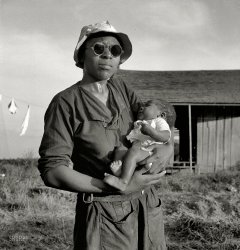
- Rex Theatre: 1937
- ... Mississippi. June 1937. View full size. Photograph by Dorothea Lange.
Tarzan It's interesting that the main feature is a Tarzan movie - ... Posted by Dave - 07/30/2012 - 2:40pm -
![Rex Theatre: 1937 Leland, Mississippi. June 1937. View full size. Photograph by Dorothea Lange.
TarzanIt's interesting that the main feature is a Tarzan movie - these were pretty racist, showing the "superior" white man among the "primitive" natives. This story is set in Guatemala, not Africa, so Lord Greystoke gets to show his stuff on a different continent.
TarzanI wonder what color they were?
Powerful photo indeed.Powerful photo indeed.
Wrong Year?The movies on the playbills would mark the year as 1935, not 1937.
[That's because the movies are two years old. Not exactly a first-run house. - Dave]
The mouths of babes.. My grand-daughter saw one of these photos and asked me, 'Gran-pa, did people used to come in different colors?', I didn't know whether to laugh or cry.
(The Gallery, Dorothea Lange, Great Depression, Movies)](https://www.shorpy.com/files/images/8b32104u.thumbnail.jpg)
- Hill House: 1936
- ... together." View full size. 4x5 nitrate negative by by Dorothea Lange for the Farm Security Administration.
Candy box? Look at the "Oh ... Posted by Dave - 09/07/2018 - 11:55am -
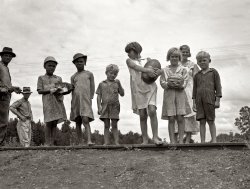
- Truck Farm: 1938
- ... No more horseshoes!" Medium-format nitrate negative by Dorothea Lange for the Farm Security Administration. View full size.
... Posted by Dave - 08/21/2009 - 2:47am -
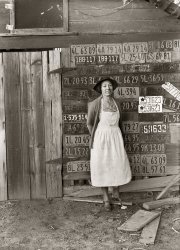
- Tater Tot: 1939
- ... September 1939. View full size. Photograph by Dorothea Lange.
Migrant/transient workers A glance at these faces serves to ... Posted by Dave - 07/05/2009 - 2:44am -
![Tater Tot: 1939 Family of migrant potato pickers in Tulelake, Siskiyou County, California. September 1939. View full size. Photograph by Dorothea Lange.
Migrant/transient workersA glance at these faces serves to remind that the agricultural miracle that brings potatoes to our tables needs workers to harvest them and they must raise their children next to these potatoes. Shouldn't Congress be looking at these photos so they can know what this country is really about?
[Potato harvesting has been automated for many years. - Dave]
faceIf you look only at mom's face, this could have been taken yesterday
She's beautiful.She's beautiful.
I'm incredibly awed by theI'm incredibly awed by the beauty, peace, hope and joy in this mother and child's faces--in stark contrast to their surroundings and situation [and fellow workers]. This was one of the most moving photos in the series for me. ....If we could only grasp a portion of their serenity, elegance and strength.....................
Tater TotI can't help being moved by this photo. The sheer innocence of the baby. He is ambivalent to the plight around him. Reminds me of my son today.
(The Gallery, Dorothea Lange, Great Depression, Kids)](https://www.shorpy.com/files/images/8b34817u_0.thumbnail.jpg)
- Tough Enough: 1936
- ... anyway you take it.'" Medium-format nitrate negative by Dorothea Lange for the Resettlement Administration. View full size.
... Posted by Dave - 10/05/2012 - 6:22am -
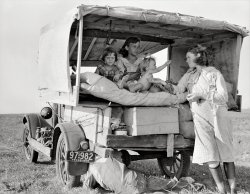
- Child of the Depression: 1935
- ... on the Bosque Farms project in New Mexico. Photograph by Dorothea Lange, 1935. View full size.
(The Gallery, Dorothea Lange, Great ... Posted by Ken - 09/08/2011 - 10:01pm -
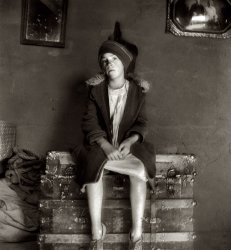
- Four of a Kind: 1939
- ... is this lady with the camera? Medium format negative by Dorothea Lange for the Resettlement Administration. View full size.
I suppose ... Posted by Dave - 10/28/2014 - 7:50pm -
![Four of a Kind: 1939 October 1939. "Boys from Dead Ox Flat waiting for the school bus in the morning. Malheur County, Oregon." So who is this lady with the camera? Medium format negative by Dorothea Lange for the Resettlement Administration. View full size.
I suppose they're brothersSame jackets, same pants, same shoes, same bag lunch, same haircut, same ears, same gaze.
Manly faceson these boys, probably brothers. I'd guess the oldest to be about fourteen. Well-dressed for school, and all with lunches. I imagine they had already performed chores at home before leaving for school, and had other responsibilities awaiting them on their return. No slackers in the crowd.
Found the MailboxThanks to the wonders of a wildcard search over at Ancestry, I was able to peg down whose mailbox they were in front of, at least.
That mailbox almost certainly belonged to a Herbert and Jessie Hudgins. Herbert and Jessie did have two children as per the 1940 Census - a daughter, Arlene, age 11, and a son named Jerry, age 6. They had moved within the past five years from Idaho (and would later move on to California).
Herbert had the unusual job title of "Ditch Rider," which is now going to bug me until I figure out just what the heck that job is or was.
Scanning up and down the census pages surrounding the Hudginses, I'm not seeing any families that would have had four boys that age (assuming they're all brothers by the matching clothing, haircuts, and cleft chins).
Two of a kind or a full house?Their identical jackets and similar features suggest familial relationships - two pairs of brothers or four brothers? Malheur County is in the southeastern part of Oregon. It's very desolate and has very few people even today.
Ditch RidersThese are people who operate irrigation systems. They are responsible for, among other things, inspecting the waterways (ditches) that convey the water throughout the system. Generally done by riding along them, hence the name.
Ditch RidingMeant riding along a ditch to ensure that the farmers were taking only the amount that they were entitled to. A crappy job inasmuch as the ditch rider normally had to get out of his vehicle at each field, open the gate, drive the vehicle through, get out again to close the gate, over and over. If the ditch he rode was many miles long he might have to do this 20-30 times a day.
3.2 People per Sq Mile!And that's today in Malheur County. What must it have been like in '39?
Some of the public schools in those remote parts operate on a weekly residence basis because it's too far to commute each day. Bus the kids in on Sunday evening and return them home on Thursday.
For all we knowThere may have been another 'set' of four (or more or less) at home that were pre-schoolers since the youngest boy looks to be about 6 or 7. In any case, they look like good, reliable kids who towed the line and perhaps they are even still with us. Personally, I like the uniforms and hope they've all had a good life.
BadlandsI guess when novelists describe a "featureless landscape", this is where they have in mind. Not without a stark sort of beauty, but pretty sparse, especially to an East Coast born and bred guy.
What's in a name?Dead Ox Flat? Malheur County?
I have the distinct impression that their grand- and great-grandparents didn't have too much of an auspicious start when they first broke turf around there.
[These kids and their families were all Dust Bowl refugees who had only recently settled in Oregon. -Dave]
Dead Ox FlatIn prowling for the location and possible IDs for the boys, I discovered that the 'proper' names for the area are either Fair, or (more commonly) Ontario. Dead Ox Flat is most likely the name of the geography in the area, as the nearby Snake River kind of bows out, leaving a somewhat 'flat' area. Someone's ox probably died there, and you wind up with an odd name.
One reason I think the census was giving me no luck finding the boys 'nearby' is that as mentioned, there were a LOT of itinerants. If you start looking around, you'll find a lot of photos of people living in tents, out of their trucks, or even in holes dug into the ground in the region back then. Those four boys could well have only owned one or two pairs of clothing, so what we see is what they had, period.
I also wouldn't be surprised if this was the first day (or close to it) of school for them for the season - in the old days school tended to revolve around the planting season for rural areas, and October would have been just about when the harvest was done, so the educating could begin.
Recycled lunch bags?Noting that the families of the boys were frugal...these lunch bags look new in that maybe it was the first day of school for the week..."now you boys remember, after lunch, to fold your lunch bag neatly and put it in your pocket"...
Bad LuckI lived in Malheur County as a kid and went to school in Vale, OR. "featureless landscape" is about right. Malheur translates from French as misfortune or bad luck which I have always thought suited the place.
(The Gallery, Dorothea Lange, Kids)](https://www.shorpy.com/files/images/SHORPY-8b35129a.thumbnail.jpg)
- House of Vines: 1938
- ... Negro quarter in Memphis, Tennessee." Nitrate negative by Dorothea Lange for the FSA. View full size.
Meanwhile, back in Tupelo ... Posted by Dave - 09/13/2011 - 2:03pm -
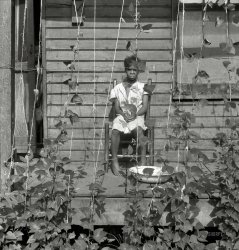
- Are We There Yet?
- ... roadside camp near Calipatria, California." Photo by Dorothea Lange for the Resettlement Administration. View full size.
Quite a ... Posted by Dave - 02/19/2013 - 12:04pm -
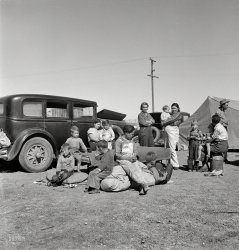
- Stump Ranchers: 1939
- ... land in three years. Medium-format nitrate negative by Dorothea Lange for the FSA. View full size.
Mennonite? There are more than ... Posted by Dave - 09/09/2011 - 12:31pm -
![Stump Ranchers: 1939 October 1939. The Unruf family. Mennonite wheat farmers from Kansas, now developing a stump ranch in Boundary County, Idaho. The mother, father and hardworking 15-year-old son with other children in yard before the barn. Father and son have cleared 30 acres of raw stump land in three years. Medium-format nitrate negative by Dorothea Lange for the FSA. View full size.
Mennonite?There are more than one flavor of Mennonite. Church and community "rules" can vary from place to place. One of the reasons the Mennonites and Amish went their separate ways long, long ago was over the issue of modernization, the Amish preferring an even more conservative approach than the Mennonites. German Mennonite farmers in Russia in the 19th century (my family) readily adopted modern farming techniques and steam powered farm equipment.
By 1939 my family was well established in the US and Canada and using tractors, cars, motorbikes, etc. They were also upstanding members of their congregations and in some cases were pastors in addition to being farmers.
For a look at how much things can vary even amongst the modern day Amish (some coverage of the Old Order Mennonites also) visit the very excellent blog:
http://amishamerica.typepad.com/amish_america/
Doug
Mennonite? Maybe.Certainly not old order/traditional--they have zippers instead of buttons, the females' heads are uncovered and they have a truck instead of a horse and buggy. You could not tell these people are Mennonite by any characteristic. Having been around them all my life, this is odd.
UnruhI have to agree that Unruh seems to be more likely - my grandmother was an Unruh and I grew up Mennonite, we weren't old order Mennonites. One interesting thing I found in researching my Mennonite roots is the fact that Mennonites in Russia were well known distillers of brandy while here in America they became teetotalers.
Spelling?My family background is Mennonite and we have some Unruh people in one branch of the family. Yes, that's an h on the end, not an f. I've not heard of the Unruf name variation before so perhaps there's a typo somewhere between 1939 and now? No matter, wonderful photo as are most all of them on Shorpy.
Doug
[I agree, Unruh seems more likely to be correct. Although the family's name is spelled Unruf in the four LOC caption records. - Dave]
(The Gallery, Agriculture, Dorothea Lange, Kids, Rural America)](https://www.shorpy.com/files/images/8b35553u_0.thumbnail.jpg)
- Lucky Pups: 1938
- ... camp instead of along the highway or in a ditch." Photo by Dorothea Lange, Resettlement Administration. View full size.
Carefree time for ... Posted by Dave - 09/27/2013 - 12:28pm -
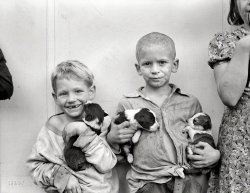
- In From the Fields: 1936
- ... Near Robstown, Texas." Medium-format nitrate negative by Dorothea Lange. View full size.
In From the Fields Another great photo Dave. ... Posted by Dave - 03/14/2008 - 8:44am -
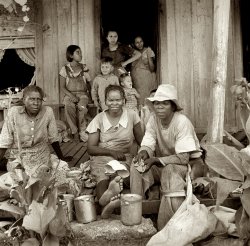
- Hoe Culture: 1936
- ... in the South. Poor white, North Carolina." Photo by Dorothea Lange for the Resettlement Administration. View full size.
He's ... Posted by Dave - 09/23/2012 - 10:08am -
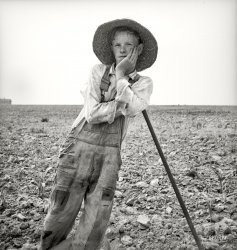
- Pineapples on Parade: 1936
- ... -- Washington, D.C." Medium-format nitrate negative by Dorothea Lange for the Resettlement Administration. View full size.
Turkeys in ... Posted by Dave - 10/04/2012 - 7:53pm -
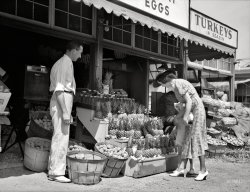
- Veteran Hobo: 1938
- ... of the World in California before the war." Photo by Dorothea Lange for the Farm Security Administration. View full size.
What's ... Posted by Dave - 04/16/2013 - 10:46pm -
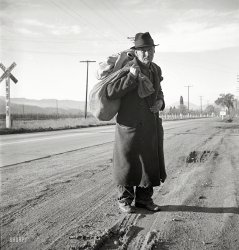
- Unemployment Lineup: 1939
- ... watch, and then pass on." Large format nitrate negative by Dorothea Lange. View full size.
In a couple more years They'll have all the ... Posted by tterrace - 05/18/2015 - 9:47am -
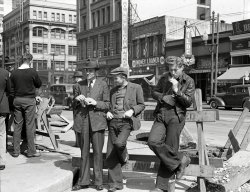
- Approaching Fresno: 1939
- ... approaching Fresno." Large-format nitrate negative by Dorothea Lange. View full size.
The Water Tower Endures Producers Cotton Oil ... Posted by Dave - 12/11/2012 - 12:28pm -
![Approaching Fresno: 1939 May 1939. "Between Tulare and Fresno. From the overpass approaching Fresno." Large-format nitrate negative by Dorothea Lange. View full size.
The Water Tower EnduresProducers Cotton Oil Company seems to still be in existence in California, but not at this location (near Calwa). All of the old buildings seem to be gone, but the water tower still stands.
(EDIT: I stand corrected. It appears that one or more of the old buildings are also still in place. The buildings central to the photograph are gone, though.)
View Larger Map
Here's another picture of the site, from September 15, 1931 (from http://content.cdlib.org/ark:/13030/c8w094sz/):
Warehouse still standing, too!@Splunge: The warehouse with the round roof on the right still exists as well. If you "drive" up to the water tower in Google Streetview you can see it's still standing.
The Hot Rod is bornSo many things here for the Shorpy masses. Railroads, trucks, cars, water towers, mid 20th century agriculture. But above all we have the birth of the Hot Rod on the left. A truly historic occasion, right there on a random sunny day, between Tulare and Fresno. Wherever that may be.
The OverpassIt seems to still be there, too! Could it be the same one from 1939? Looks sorta modern.
[It is the same one. Now South Golden State Blvd., it was US 99 when Lange took shots showing the roadway in which you can see the side railings match. Also, note these Art Deco embellishments. - tterrace]
And from the airNot as peaceful now. From Google Maps.
(The Gallery, Dorothea Lange, Railroads)](https://www.shorpy.com/files/images/SHORPY_8b33701u.thumbnail.jpg)























